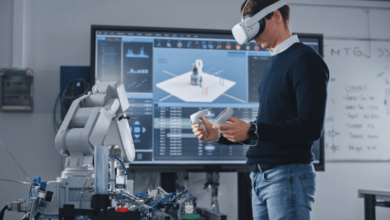AI and Machine Learning in Predictive Analytics

Introduction
Predictive analytics is at the forefront of modern data-driven decision-making. By analyzing historical data, organizations can forecast future trends, behaviors, and outcomes with remarkable accuracy. At the heart of this transformative approach are artificial intelligence (AI) and machine learning (ML). These technologies have revolutionized predictive analytics, enabling businesses to process vast amounts of data, uncover patterns, and make informed decisions in real time. This article explores the integration of AI and ML in predictive analytics, their applications, benefits, challenges, and the potential they hold for the future.
What Is Predictive Analytics?
Predictive analytics refers to the use of statistical techniques, data mining, and machine learning algorithms to predict future outcomes based on historical data. By leveraging these methods, businesses can identify risks, seize opportunities, and make proactive decisions. Traditional predictive models relied heavily on manual processes and fixed algorithms. However, with the advent of AI and ML, predictive analytics has become more adaptive, precise, and scalable.
The Role of AI and Machine Learning in Predictive Analytics
AI and ML are the driving forces behind modern predictive analytics. AI enhances decision-making by enabling systems to simulate human intelligence, such as reasoning, learning, and problem-solving. ML, a subset of AI, focuses on creating algorithms that learn from data, identify patterns, and improve over time without explicit programming. Together, these technologies enable predictive analytics systems to handle large datasets, uncover hidden trends, and make predictions with unparalleled accuracy. They also allow for real-time analysis, enabling organizations to react quickly to changing conditions.
Key Components of Machine Learning in Predictive Analytics
- Supervised Learning
Supervised learning is one of the most commonly used ML techniques in predictive analytics. It involves training algorithms on labeled datasets, where the input and corresponding output are already known. These models can then predict outcomes for new, unseen data. Applications include fraud detection, credit scoring, and demand forecasting. - Unsupervised Learning
Unsupervised learning analyzes datasets without predefined labels, making it ideal for discovering hidden patterns or structures. Clustering and association techniques help identify customer segments, market trends, and anomalies in data. - Reinforcement Learning
Reinforcement learning allows models to learn through trial and error by interacting with their environment. It is particularly useful in dynamic scenarios such as stock trading, personalized marketing, and autonomous systems. - Deep Learning
Deep learning, a subset of ML, uses neural networks with multiple layers to process and analyze large and complex datasets. It excels in image recognition, natural language processing, and other advanced tasks, making it a critical tool in predictive maintenance and healthcare analytics.
Applications of AI and Machine Learning in Predictive Analytics
- Healthcare
AI and ML have transformed healthcare predictive analytics. Models predict disease outbreaks, identify at-risk patients, and recommend personalized treatments. Predictive analytics also supports hospital resource management, optimizing bed allocation and staff scheduling during peak periods. - Finance
In the financial sector, predictive analytics helps institutions assess credit risk, detect fraud, and forecast market trends. ML algorithms analyze transaction patterns to identify anomalies, protecting businesses and consumers from fraudulent activities. - Retail and E-Commerce
Retailers use predictive analytics to forecast demand, optimize inventory, and personalize marketing strategies. By analyzing customer behavior, businesses can recommend products, tailor promotions, and enhance the overall shopping experience. - Supply Chain Management
Predictive analytics improves supply chain efficiency by forecasting demand, identifying potential disruptions, and optimizing logistics. ML models analyze historical and real-time data to ensure timely delivery and cost savings. - Energy and Utilities
In the energy sector, predictive analytics is used for load forecasting, grid optimization, and predictive maintenance of equipment. AI models analyze weather patterns, consumption trends, and system data to enhance reliability and efficiency.
Benefits of AI and Machine Learning in Predictive Analytics
The integration of AI and ML into predictive analytics offers numerous advantages. Enhanced accuracy is one of the most significant benefits, as these technologies can process vast datasets and uncover subtle patterns that traditional methods might miss. Real-time insights allow organizations to respond swiftly to changing conditions, minimizing risks and capitalizing on opportunities. AI-driven predictive analytics also improves operational efficiency by automating repetitive tasks, freeing up resources for strategic initiatives. Furthermore, personalized predictions enable businesses to tailor products, services, and experiences to individual customer needs, fostering loyalty and satisfaction.
Challenges in Implementing AI and Machine Learning in Predictive Analytics
Despite their potential, implementing AI and ML in predictive analytics comes with challenges. Data quality and availability are critical concerns, as models are only as good as the data they are trained on. Incomplete or biased datasets can lead to inaccurate predictions. The complexity of AI and ML models can also be a barrier. Developing and maintaining these systems requires expertise in data science, which may not be readily available to all organizations. Data privacy and security are additional challenges, as predictive analytics often involves handling sensitive information. Ensuring compliance with regulations and protecting user data is essential to maintain trust and avoid legal repercussions.
The Future of AI and Machine Learning in Predictive Analytics
The future of predictive analytics lies in the continued evolution of AI and ML technologies. Advances in explainable AI aim to address the “black box” problem, making predictions more transparent and understandable. Quantum computing has the potential to revolutionize predictive analytics by enabling faster processing of complex datasets. Edge computing will bring predictive analytics closer to data sources, enabling real-time decision-making in industries like IoT and autonomous systems. As predictive analytics becomes more accessible, its adoption across industries is expected to grow, driving innovation and creating new opportunities.
How Businesses Can Leverage Predictive Analytics
To harness the power of AI and ML in predictive analytics, businesses should invest in data infrastructure and talent. High-quality data collection and management systems are essential for building accurate models. Partnering with AI experts or adopting user-friendly platforms can streamline implementation. Businesses should also align predictive analytics strategies with organizational goals, ensuring that insights lead to actionable outcomes. Regularly evaluating and updating models ensures they remain effective as data and market conditions evolve.
Conclusion
AI and machine learning have transformed predictive analytics into a powerful tool for businesses and organizations. From healthcare and finance to retail and energy, the applications of these technologies are vast and varied. While challenges such as data quality and model complexity persist, ongoing advancements promise to overcome these obstacles and unlock even greater potential. By embracing AI and ML in predictive analytics, organizations can make informed decisions, drive innovation, and gain a competitive edge in an increasingly data-driven world.




